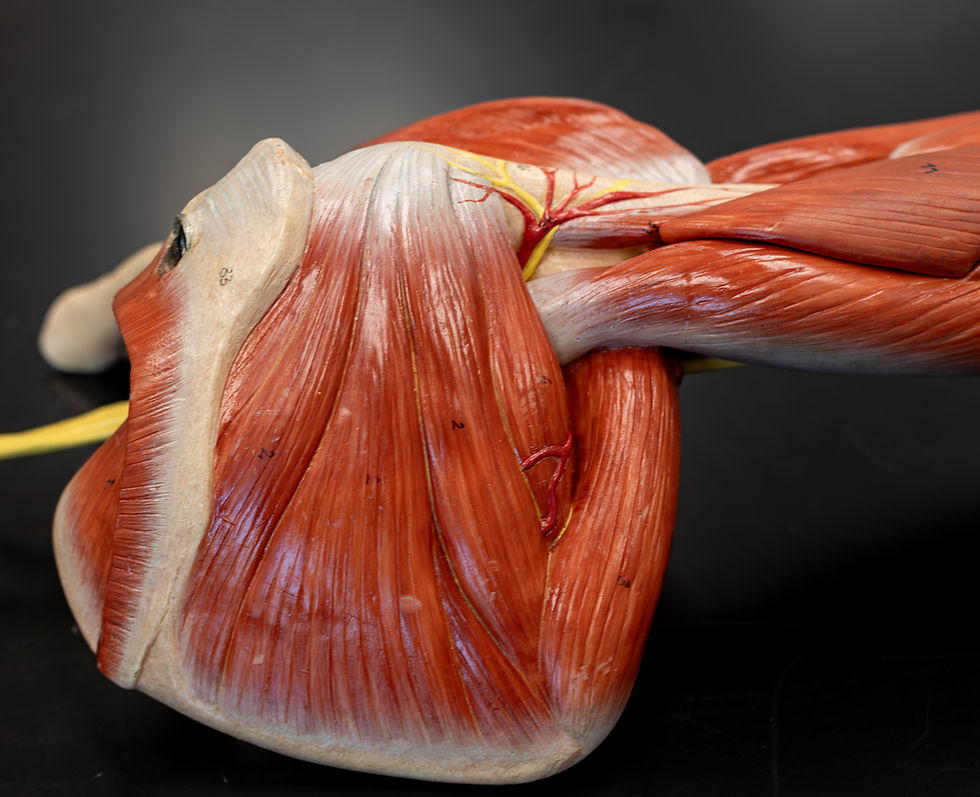Yoga for Shoulder Pain and Injuries After 50: How Therapeutic Yoga Supports Healing and Mobility
- Joy Zazzera

- Jun 30, 2024
- 4 min read
Updated: Aug 6
Yoga for shoulder pain offers a smarter, more sustainable path forward—especially for adults over 50 navigating stiffness, injury, or degenerative changes.
If we’re fortunate enough to live a long life, some level of joint degeneration is inevitable. But degeneration doesn't have to mean pain.
In fact, shoulder pain in aging bodies is often less about the severity of the “damage” and more about movement quality, muscular imbalance, and how well the shoulder is supported by the surrounding structures. This is where yoga therapeutics—especially when personalized—can offer a profoundly healing approach.
If you're exploring yoga for shoulder pain, it's important to know that not all movement is created equal—therapeutic yoga for shoulder pain focuses on safe, strategic practices tailored to your needs, making yoga for shoulder recovery more effective and sustainable as you age.
Why Shoulders Hurt: Understanding the Root of Dysfunction
The shoulder is the most mobile joint in the human body—but that mobility comes with a trade-off: low passive stability. With age or overuse, many people develop pain, weakness, or loss of motion due to:
Rotator cuff tendinopathy or tears
Biceps tendinosis or subluxation
Frozen shoulder (adhesive capsulitis)
Shoulder impingement
Postural dysfunction and anterior shoulder carriage
Scapular instability or poor thoracic mobility
Osteoarthritis or bone spurs
Some of these may arise from injury, others from disuse, repetitive strain, or tension patterns that have quietly developed over time. And some may not be painful at all—yet still impact movement and quality of life.

Pain Isn’t Always the Problem
Pain can be confusing. Sometimes it comes from inflammation or tissue overload. Other times, it reflects nervous system sensitivity, not actual damage. One person may have a full-thickness rotator cuff tear and feel no pain. Another might experience sharp pain from minor muscular irritation.
Pain also tends to fall into three groups when observing shoulder movement:
Group 1: Strong pain that significantly limits function and range of motion (often needs medical referral).
Group 2: Moderate pain that limits movement or strength.
Group 3: Mild or no pain, but noticeable functional restrictions.
Understanding where someone falls helps determine whether gentle yoga therapeutics is appropriate—or whether they need referral to a PT or MD first.

The Shoulder Needs More Than Stretching
Yoga is often associated with flexibility, but stability is equally—if not more—important for shoulder health. The glenohumeral joint (ball-and-socket) is stabilized by:
Deep muscles like the rotator cuff (supraspinatus, infraspinatus, subscapularis, and teres minor)
Scapular stabilizers like the serratus anterior and trapezius
Thoracic mobility and posture
The tension and integrity of connective tissues
These structures must work together like a team. When one area underperforms, another will compensate. That’s how chronic patterns form—and why many people struggle with recurring pain or tightness.
Osteoarthritis & Aging Shoulders: Movement Still Matters
Osteoarthritis (OA) is common—by age 55–78, nearly 70% of adults show signs of OA on imaging. But OA doesn’t automatically mean pain. Most shoulder arthritis occurs gradually as the body attempts to protect the joint. Bone spurs (osteophytes) and cartilage thinning are part of that adaptation.
Key point? You can’t reverse arthritis, but you can slow its progression and improve function.
A fascia-informed, yoga therapeutic approach helps:
Lubricate joints by moving synovial fluid
Hydrate connective tissue and combat stiffness
Optimize muscular balance between overworking and underworking tissues
Challenge tissue capacity through safe, eccentric loading
Reduce guarding and nervous system overprotection
The Role of Fascia, Trigger Points, and Tension
Shoulder dysfunction isn’t just about joints and muscles—it’s about the fascia and nervous system too. Trigger points or adhesions in connective tissue can:
Adhere to nerves or vessels, causing tingling or radiating discomfort
Create tension that limits range of motion
Mimic pain elsewhere in the body
Yoga therapeutics addresses this by combining:
Self-myofascial release (MFR)
Gentle, mindful mobility
Breathwork to modulate the nervous system
Proprioceptive awareness to improve coordination
This creates a system-wide improvement in how the shoulder functions—not just in one pose or position, but in daily life.
What to Expect in a Therapeutic Yoga Practice for Shoulders
Working 1-on-1 or in a small group where therapeutic yoga for shoulder pain is the primary focus, I help adults:
Identify movement limitations (even subtle ones)
Learn safe, joint-conscious techniques for strengthening and stabilizing
Explore shoulder-friendly adaptations for yoga poses
Relieve tension and improve tissue hydration through fascia-informed movement
Develop consistent, supportive routines for aging joints
We don’t just stretch what’s tight. We strengthen what’s weak, restore optimal mechanics, and build capacity over time.
Who Is This For?
This approach is ideal for:
Women 50+ seeking a safe, intelligent yoga practice
Adults with past injuries, scar tissue, or surgical repairs (e.g., rotator cuff surgery or shoulder replacement)
Anyone experiencing tension, guarding, or reduced mobility
Those with early-stage arthritis or chronic shoulder “wear and tear”
You don’t need to be flexible or experienced—just willing to listen to your body and take one step at a time.
Movement is Medicine—When It’s the Right Kind
Shoulder pain doesn’t have to be a life sentence. When it comes to healing shoulder pain or recovering mobility, not all movement is created equal. Working with a teacher trained in yoga therapeutics ensures your practice is safe, strategic, and tailored to your specific needs—especially if you're navigating injury, arthritis, or age-related changes. Injured or aging shoulders need more than just generic stretches. They require a skilled eye, precise progression, and guidance from someone who understands how to restore function from the inside out. While many yoga practices offer movement, few offer the assessment, adaptation, and long-term strategy that true healing requires. My approach blends modern movement science with yoga’s most therapeutic tools—so your shoulder care plan is both intelligent and intuitive.
If you're ready to explore your shoulder health through the lens of yoga therapeutics, begin with my therapeutic video support offering, or join the wait-list for an upcoming digitally delivered program for shoulder mobility and strength.







Comments